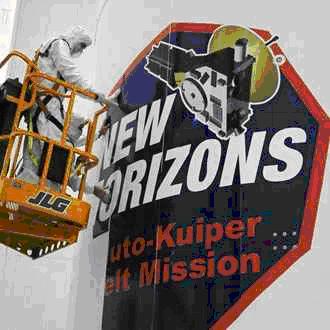Unlike the rocky inner planets (like Earth) or the outer gas giants, Pluto is a new type of planet known as an "ice dwarf", of the type common in the Kuiper Belt, which is billions of kilometers from the Sun.

"The New Horizons spacecraft will explore a unique world, and we can only imagine what we will learn from this journey. This is a prime example of a science mission that matches the vision of space exploration," said Marie Cleve, assistant administrator for NASA's Science Mission Directorate.
The vision of space exploration is a completely new route into the universe, a journey in which the shuttles will return to safe flights, the construction of the International Space Station will be completed, humans will return to the moon and eventually continue to Mars and beyond.
The US National Academy of Sciences has ranked Pluto-Charon and the Kuiper Belt exploration among the highest priority missions in space exploration, noting the fundamental scientific importance of these bodies to advancing our knowledge of the Solar System.
Unlike the rocky inner planets (like Earth) or the outer gas giants, Pluto is a new type of planet known as an "ice dwarf", of the type common in the Kuiper Belt, which is billions of kilometers away from the Sun. "Exploring Pluto and the Kufir belt may produce an archaeological dig into the history of the outer solar system, a place where we can observe an ancient region of the formation of the solar system," said Alan Stern, chief scientist of the New Horizons project, from the Department of Space Studies at the Southwest Research Institute in Boulder, Colorado.
The spacecraft was designed and built by Johns Hopkins University's Applied Physics Laboratory in Laurel, Maryland. As currently planned, the launch window extends from January 17, 2006 to February 14, XNUMX.
The compact spacecraft, the size of a piano weighing 476 kg, will be launched on an elongated Atlas 5 rocket, to which a solid fuel booster will be attached. New Horizons will be the fastest spacecraft ever launched and will cross the orbit of the Moon in nine hours and the orbit of Jupiter in 13 months.
A launch before February 3rd would also allow the spacecraft to fly close to Jupiter in early 2007 and use its gravity as an accelerator towards Pluto. A flyby close to Jupiter will cut five years off the journey and provide an opportunity to test the spacecraft's instruments and its ability to approach the Jupiter system.
The spacecraft's payload was developed under the supervision of the Southwest Research Institute, and it includes infrared and ultraviolet imaging systems, a multi-color camera, a long-range telescopic camera, two particle spectrometers, a dust detector and a scientific radio system. The dust detector was designed and built by students at the University of Colorado in Boulder.
Depending on the launch date, the spacecraft will be able to reach Pluto starting in mid-2015, completing a five-month mission only possible from this point of approach of the spacecraft. It will characterize the global geology and geomorphology of Pluto and Charon, map surface composition and heat measurements, and investigate Pluto's atmospheric composition and structure. New Horizons will also explore the recently discovered small moons in the Pluto system.
The spacecraft will "sleep" in electronic hibernation for most of its trip to Pluto. The operators will turn off most of the electronic systems, except for the essential ones, and will inspect the spacecraft once a year to test the critical systems, calibrate the instruments and make course corrections, if necessary.
The spacecraft will transmit a beacon signal every week to provide operators with a quick reading of its health signals. The entire spacecraft will consume electricity from one radioisotope generator that will provide a little less power than two 100-watt household light bulbs.
https://www.hayadan.org.il/images/content1/353805847-L-new_horizons-1.jpg
Charon, a moon of Pluto with a radius of about 600 km, has no atmosphere. And probably not a spherical shape either
